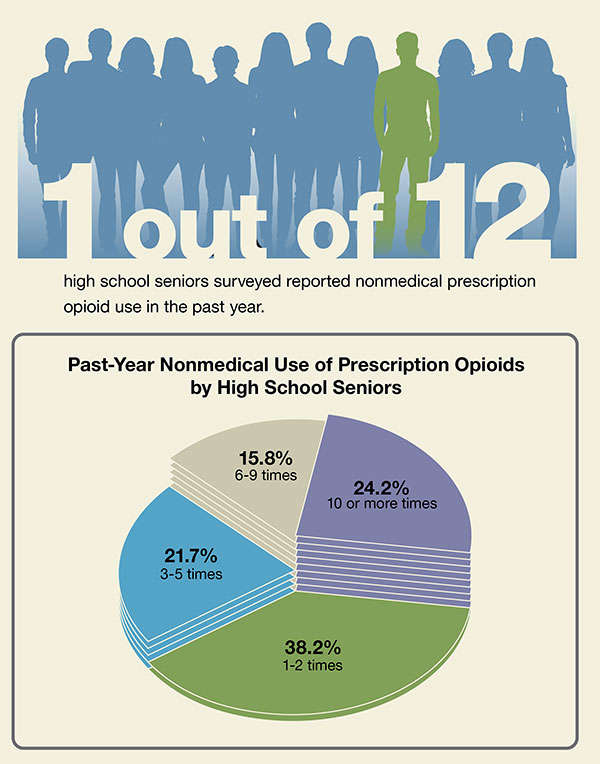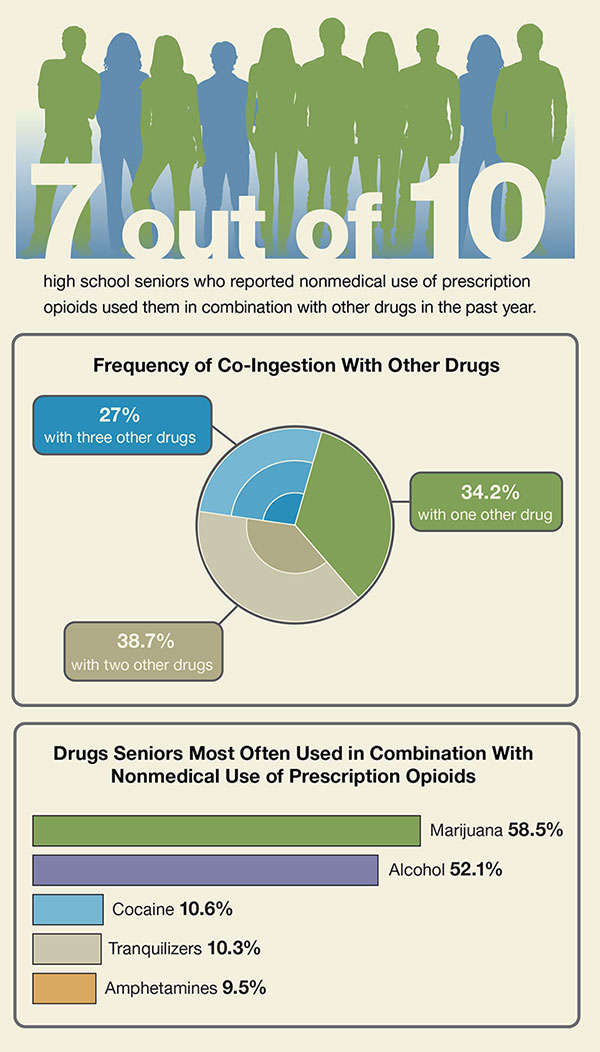In the years 2007 to 2009, more than 1 in 5 high school seniors nationwide had used an opioid painkiller (e.g., Vicodin, OxyContin, Percodan, Percocet, Demerol, Dilaudid, morphine, or codeine) at least once in their lives. Roughly 1 in 8 had used these medications without a doctor instructing them to do so. Any history of such nonmedical opioid use should raise a red flag for a person’s potential engagement in multiple problematic substance-related behaviors.
The findings, by Drs. Sean Esteban McCabe, Carol Boyd, and Brady West at the University of Michigan and Dr. Christian Teter of the University of New England, highlight the need for physicians to exercise caution in prescribing opioid analgesics to teens. The research also identified several problem behaviors whose presence can alert physicians that a teen requires particularly close monitoring when treated with these medications. The behaviors include using an opioid for motives other than pain relief, co-ingesting an opioid with other drugs, and using non-oral routes of opioid administration.

High School Seniors’ Medical and Nonmedical Opioid Exposures
Dr. McCabe and colleagues estimated high school seniors’ prescription opioid exposures based on teens’ responses to the Monitoring the Future (MTF) study. Each year, MTF asks approximately 50,000 8th, 10th, and 12th graders to report anonymously on many aspects of their experiences and attitudes.
Between 2007 and 2009, over 7,000 12th graders filled out an MTF sub-questionnaire that solicits indepth information about substance use. Of these students, 22.3 percent had used a prescription opioid medically or nonmedically at least once in their lives.
There were marked racial differences in the prevalence of such exposures. Nearly 23 percent of white students reported medical use, and 16 percent reported nonmedical use of a prescription opioid at least once. The corresponding rates were 7 percent and 4 percent among African American students, and 7 percent and 6 percent among Hispanic students. The researchers surmise that these differences may reflect racial differences in medical availability and doctors’ prescribing practices.
Exposure Patterns Predict Behaviors
The Michigan‒New England researchers compared opioid-exposed and unexposed students’ likelihood of engaging in several dangerous substance-related behaviors. They found that students whose first exposure to an opioid had been nonmedical were 4 times as likely as unexposed students to have taken one of these medications to feel good or get high; 4 to 5 times as likely to have bought prescription opioids from a friend, relative, drug dealer, or stranger; and 7 to 9 times as likely to have taken a prescription opioid intranasally. In contrast, students whose only opioid exposure had been according to a doctor’s orders had the same likelihood of engaging in these behaviors as students who had never used or misused an opioid.
The researchers also found that, of 900 seniors who reported using an opioid nonmedically on the 2002‒2006 MTF, 70 percent had co-ingested another substance, most often marijuana or alcohol, while under the influence of the opioid. Compared to those who had not co-ingested, these who had were 3 times as likely to have taken an opioid to feel good or get high, and 4 times as likely to have taken a prescription opioid intranasally.

Advice to Prescribers
Dr. Moira O’Brien, Program Officer in NIDA’s Epidemiology Research Branch, comments, “This research is highly significant because it shows how commonly high school students are exposed to prescription opioids. This is also the first study to show how students take opioids with other drugs, revealing dangerous drug combinations.”
“Based on the potentially fatal consequences associated with co-ingestion of prescription opioids with other drugs, the finding that 7 out of 10 nonmedical users report co-ingestion of prescription opioids and other drugs in the past year is staggering,” says Dr. McCabe. He notes that alcohol, marijuana, and opioids all share some neurological and physiological effects. They therefore can amplify each other’s adverse impacts when taken together—including, the new findings suggest, those that underlie problematic drug use and addiction.
“We believe prescription opioids can be safely prescribed to adolescents, but prescribers should take precautions,” Dr. McCabe says. He and his team recommend that prescribers carefully monitor the quantity of new prescriptions and refills. Among the MTF respondents who reported taking an opioid nonmedically, many used opioids remaining from their own prior prescriptions.
The researchers advise doctors to educate patients to take opioids as prescribed, counsel them not to share medications, advise them to store medications in a safe place, and remind them to properly dispose of unused medications. They also encourage prescribers to screen all patients for potential substance-related problems.
The new findings build on previous work by the research team. They indicate that screening can be strengthened by including questions about teens’ history and motives for nonmedical opioid use and other forms of prescription opioid misuse, such as using too much, co-ingestion of opioids with other substances, and non-oral routes of administration.
This study was supported by NIH grants DA024678, DA031160, DA01411, DA024678-03, DA024678-04, DA031160-01, and DA031160-02.
Sources
McCabe, S.E.; West, B.T.; Teter, C.J.; and Boyd, C.J. Co-ingestion of prescription opioids and other drugs among high school seniors: results from a national study. Drug and Alcohol Dependence 126(1-2):65-70, 2012a. Abstract
McCabe, S.E.; West, B.T.; Teter, C.J.; and Boyd, C.J. Medical and nonmedical use of prescription opioids among high school seniors in the United States. Archives of Pediatric and Adolescent Medicine 166(9):797-802, 2012b. Full Text
Related Resource: Family Checkup
To help parents raise happy, healthy, drug-free teens, NIDA provides the research-based tool, “Family Checkup: Positive Parenting Prevents Drug Abuse.”
This resource centers around five questions that highlight essential parenting skills, such as communicating calmly, setting limits, and providing encouragement and support. Each section includes video examples of positive and negative interactions between parents and teens, and gives tips for improving communication.
Explore “Family Checkup: Positive Parenting Prevents Drug Abuse.”